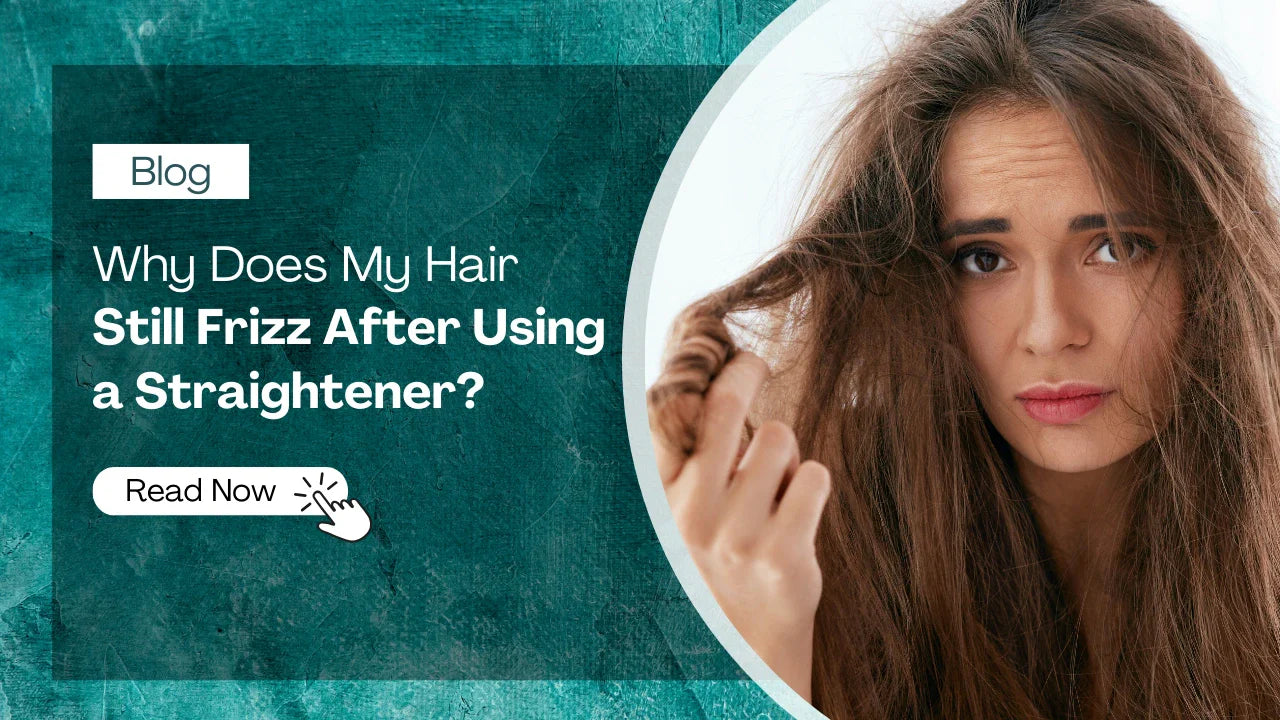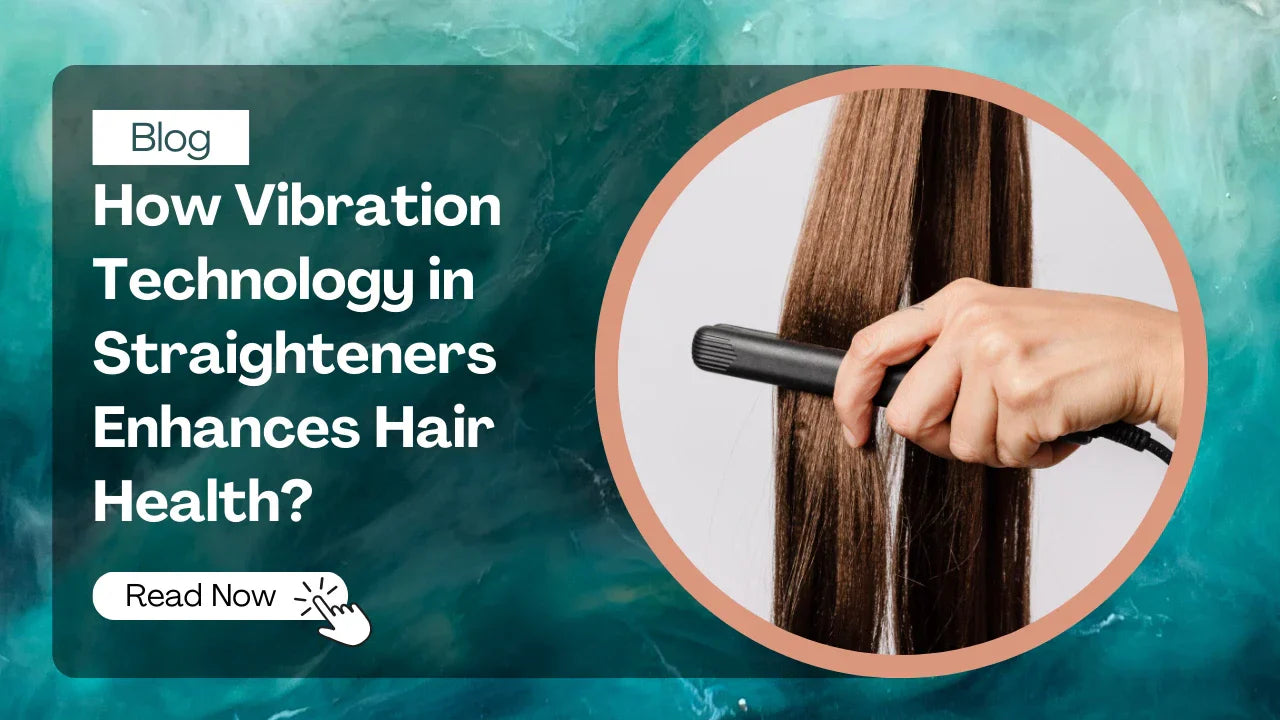What can be more annoying than going through frizzy hair? Especially when you have spent hours styling them with a straightener. If this frustration sounds familiar, you’re not alone, and there are clear reasons behind it. We have got you covered.
This guide will discuss key reasons and common mistakes that make your hair frizzy after straightening it. Plus, we have added expert tips and a go-to hair straightener to eliminate frizz and achieve beautiful straight locks. So, without delay, let’s dive in!
Why Does Your Hair Still Frizz After Straightening?
Here are the key culprits that cause frizz after straightening hair:
- Moisture imbalance
Maintaining the right moisture balance is key to keeping your hair sleek, shiny, and manageable. Excessive moisture can make your hair swell and revert the straightening results.
On the other hand, overly dry hair absorbs moisture from humid air and causes frizz. Therefore, it’s crucial to use products that balance moisture levels and seal it in before you straighten your hair.
- Wrong heat setting
Using the wrong temperature setting while styling your hair can directly affect how your hair looks and feels. Excessive heat can strip away hair’s moisture, giving straight yet prone to frizz hair. On the other hand, too low a temperature demands multiple passes and doesn’t offer enough heat to shape your hair as you desire.
- Damaged hair cuticle
When hair cuticles are damaged, they struggle to hold any style effectively. A straightener can temporarily smooth and align the cuticles, giving your hair that sleek, polished finish. However, the effect is often short-lived.
Gradually, the weakened cuticles lift again, absorbing excess moisture from the environment or allowing internal moisture to escape. This moisture imbalance leaves your hair feeling rough and frizzy.
- Environmental factors
Environmental factors like wind, humidity, and pollution can quickly undo all the effort you put into styling your hair. These elements disrupt the hair's cuticle layer, leading to puffiness, frizz, and a loss of sleekness. While you can't completely avoid environmental exposure, you can minimize its impact. Simple steps like wearing a cap or scarf outdoors or using anti-frizz and humidity-resistant hair products can help you make a noticeable difference in keeping your hair straight and smooth.
Common hair straightening mistakes that cause frizz
Even after using the right products, certain mistakes during straightening can still lead to frizz. Here are a few common hair-straightening mistakes that encourage frizz:
- Skipping heat protectant: Heat protectant serum helps create a protective barrier on your hair shaft, which ensures that your hair is shaped without damaging the cuticle. Skipping this step damages your cuticle, which leads to frizz and hair damage in the long run.
- Using the wrong straightener: Cheap chair straighteners with low-quality plates and no advanced features can put your styling efforts in vain. Low-quality hair straighteners offer uneven heat distribution, tug hair, and generate static, leading to rough, frizzy hair.
- Not sealing the cuticle: Always consider using a finishing product like serum or setting spray after straightening hair. These products help seal the cuticle and hold the hairstyle longer.
- Straightening wet hair: The worst thing you can ever do to your hair is straightening it when wet. It’s a major no. Always ensure your hair is completely dry before you expose it to the flat iron.
- Not having pre- and post-styling routines: Perfect hair straightening begins before you even plug in the straightener. A solid pre- and post-styling routine with the right products can lay the foundation for long-lasting, frizz-free results. Having the right foundation and finishing steps can be a game-changer in how your hair looks and feels after straightening.
Expert Tips to Prevent Frizz While Straightening Hair
As you know, the reasons and common mistakes that cause damage are as follows: Let’s see our experts take on the same. Here are 6 tips from our experts to prevent frizz while straightening hair:
- Build a pre- and post-styling routine
Build a good pre-and post-styling routine. Start with gentle moisturizing shampoo and conditioner to hydrate hair. Regarding the finishing routine, consider investing in serum, hair spray, or leave-in conditioner based on your hair type and needs.
- Use moisturizing and anti-frizz products
Pay more attention to product ingredients than labels. Look for hair care products with argan oil, shea butter, and more that specifically help coat hair and create a barrier from humidity and static. Besides, you can consider anti-frizz or humidity-resistant hair products for better protection. However, ensure multiple products don’t weigh your hair down.
- Use high-quality titanium or tourmaline straighteners.
Use high-quality hair straighteners with titanium or tourmaline plates. These advanced materials emit negative ions that help reduce frizz and allow the plates to glide smoothly over your hair. As a result, it straightens you faster, with minimal effort and less heat exposure. Although these straighteners are expensive, they often include advanced features, offer long-lasting durability, and deliver salon-like results, making them well worth the investment.
- Set heat styling tools on low-temperature
Always understand your hair type and its tolerance before applying heat. If you're unsure about the ideal temperature, start with the lowest setting and gradually increase it until you find the minimum effective level that straightens your hair without causing stress or damage.
Not all styling tools offer adjustable temperature settings. So, if your device has fixed heat, it's safest to opt for a medium setting to reduce the risk of overexposure and stick to low if you have fine and thin hair.
- Learn the right hair-straightening technique
Sometimes, the problem isn’t your hair or tool. It’s the technique. Always apply a heat-protectant serum and ensure your hair is fully detangled. Divide your hair into manageable sections, and start straightening from the back of your head for easier styling and better control.
Run a bristle brush alongside the straightener for a smoother finish and better cuticle sealing as you glide down each section. Let your hair cool completely before touching or styling it further, and finish with a lightweight product to lock in the sleekness. This approach can help you see significant differences in the results.
Read more: Pro Tips for Straightening Hair Without Frizz
Best Hair Straightener for Frizz-Free Results: Expert Recommendation
When it comes to sleek, frizz-free hair, the right tool is one of the most crucial factors as it impacts the result and hair health equally. Our experts suggest Artisto Eligna as a go-to hair straightener due to its irresistible features. This tool offers adjustable temperature settings ranging from 150 °C to 250 °C with vibration technology, making it ideal for all hair types.

Its titanium plates and negative ion technology reduce frizz and enhance shine, ensuring even heat distribution with minimal passes. Plus, the beveled edges make it perfect for soft curls and waves, making it a versatile, must-have tool for professional and personal use.
Conclusion
Many factors, including styling technique, environment, moisture imbalance, straightener, and hair care products, can be the reason behind frizzy hair after straightening. In this guide, we explored the most common mistakes that lead to post-straightening frizz, along with expert insights to help you avoid them. So, bookmark this post for your next styling session, and don’t forget to shop the advanced tools only on Artisto.




Leave a comment
This site is protected by hCaptcha and the hCaptcha Privacy Policy and Terms of Service apply.